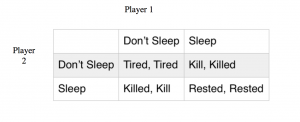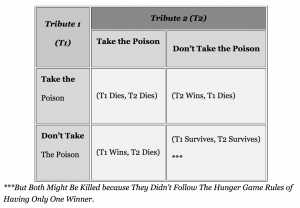Game Theory in The Hunger Games
Almost every phenomenon in life, society and nature alike, can be described by a set of mathematical equations. This is true for DNA and genetics, for Cornell’s housing lottery system, and for the upcoming presidential election of Clinton vs. Trump. Concepts of probability and Game Theory can also be relevant in works of fiction and literature. The Hunger Games trilogy, which remains immensely popular as books and as movies, is one such instance. Michael A. Lewis, a professor at Hunter College, and a finance blogger named Tim comment on these ideas in the below links. The first Hunger Games novel, where one of its most quotable lines is “May the odds be ever in your favor,” is a prime example where nearly all the events that occur are dictated by probability and the strategic behaviors of characters.
Before divulging into the mathematics present in the novel, we first need a understanding of its basic premise. The Hunger Games takes place in a futuristic, dystopian society where a certain few have affluent and opulent lives in the Capitol. The rest of the citizens reside in 12 outlying Districts where they live and serve in poverty for the benefit of an oppressive government. Every year, there is a televised competition named The Hunger Games where twenty-four children, two from each district, are forced to kill and avoid death in order to be the lone victor.
The two dominating ideas present in the plot are probability of entering the arena and Game Theory for when the Tributes are actually competing with each other. The main focus of this post will be on the Game Theory aspect as it is very relevant to the current course material.
As a game where you’re competing for your life, a person’s strategy will depend highly on the predicted behavior of his opponent. One such example is the decision to sleep or stay awake at night. Early in the Games, groups or coalitions form to gang up on other opponents. However, all the alliances will eventually end and the choice to sleep or stay awake could be a matter of life or death. The following table exemplifies each potential outcome:
It is better for each player to stay awake each night to ensure their safety. However, this is complicated by the fact that this long term-strategy will render the player vulnerable against other, better rested opponents. Similarly, in the class example of soccer penalty kicks, using the same strategy over and over again will not dwell well. An offensive player who constantly kicks right will be exploited by the goalie, who will know which direction to defend. Alternating randomly between different choices adds ambiguity to the situation which can help a person’s outcome.
Another example of Game Theory occurs toward the end of the novel (spoilers below). The protagonist and her love interest are the remaining two players in the game. They have a choice between suicide and staying alive where the outcome depends on the action of the other person. The chart below explains the situation:
This is complicated by the players’ feelings toward each other where neither wants to live with the other person dead. At the same time, an innate instinct to survive empowers them to not take the poison. This situation is a tricky one where the players need to be fairly confident about the other’s decision while making their own. This is true for every Game Theory situation discussed in class where each person is motivated by the potential actions of his opponent.
Real-life examples of game theory and probability are typically not as morbid as children killing each other. However, inclusion of such concepts, along with deep questions about morality and ethical dilemmas, adds a level of sophistication to the novel and makes for an interesting read.
References:
https://www.wired.com/2012/04/probability-and-game-theory-in-the-hunger-games/
http://www.patheos.com/blogs/faithandfinance/2012/03/28/hunger-games-game-theory/
Collins, Suzanne. The Hunger Games. New York: Scholastic Corporation, 2008. Print.


